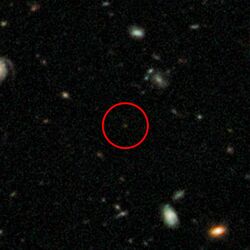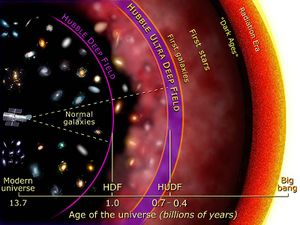UDFy-38135539
| UDFy-38135539 | |
|---|---|
 Hubble Space Telescope image of UDFy-38135539 | |
| بيانات الرصد (حقبة J2000) | |
| الكوكبة | Fornax |
| صعود مستقيم | 03h 32m 38.13s[1] |
| الميل | -27° 45′ 53.9″[1] |
| السرعة القطرية الشمسية | 2,581,213 km/s |
| المسافة | 13.1 billion light-years (4.0 billion parsecs) (light travel distance)[2] ~30 billion light-years (9.0 billion parsecs) (present proper distance)[3] |
| النوع | Dwarf |
| المقاس (س.ض.) | 10,000 ly (diameter) |
| عدد النجوم | 1 billion (1×109) |
| الأبعاد الظاهرة (V) | 0.0025 x 0.0025 |
| القدر الظاهر (V) | V fainter than 30.2[4] H160 = 28.1[1] (detected by HST in J and H bands)[1] |
| تسميات أخرى | |
| HUDF.YD3, TST2010 3, MDC2010 1721 | |
UDFy-38135539 (ويعرف أيضا باسم "HUDF.YD3") هي مجرة تقع على مسافة 9.1 بليون فرسخ (حوالي 30 بليون سنة ضوئية), مما يجعلها أبعد جسم معروف تم رصده في الكون عن الأرض. اكتشفتها ثلاث مجموعات في سبتمبر 2009 عن طريق الأشعة تحت الحمراء الحساسة لتلسكوب هابل (source UDF-38135539 in Rychard Bouwens et al.[1], source HUDF.YD3 in Andrew Bunker et al.[5], and source 1721 in Ross McLure et al.[6]), ونشر عنها في مجلة الفيزياء الفلكية، وفي الاشعارات الشهرية للجمعية الفلكية الملكية.
It was discovered by three teams in September 2009 in sensitive infrared Hubble Space Telescope images and identified by these as source UDF-38135539 (R Bouwens et al.[1]), source HUDF.YD3 (A Bunker et al.[5]) and source 1721 (R McLure et al.[6]), and additionally reported in the Astrophysical Journal, and the Monthly Notices of the Royal Astronomical Society. All teams independently identified the source to likely be an extremely distant galaxy because there was no measurable light at visible wavelengths (caused by absorption of hydrogen gas along the line of sight). Following the discovery of this candidate distant galaxy, another team targeted this object with ground-based spectroscopy to confirm the distance, reporting a redshift z=8.6.[4] However, attempts to replicate this observation strongly suggest the original claim was in error, meaning that at the present time the galaxy only has a photometric redshift estimate.[7]
. . . . . . . . . . . . . . . . . . . . . . . . . . . . . . . . . . . . . . . . . . . . . . . . . . . . . . . . . . . . . . . . . . . . . . . . . . . . . . . . . . . . . . . . . . . . . . . . . . . . . . . . . . . . . . . . . . . . . . . . . . . . . . . . . . . . . . . . . . . . . . . . . . . . . . . . . . . . . . . . . . . . . . . .
الاكتشاف
Its first known imaging was in Hubble telescope's Hubble Ultra Deep Field, the most detailed deep space picture at that time.[2] The galaxy was observed in August and September 2009.[2][8] The image data was released to the scientific community, which led to the galaxy's detection by the teams of Bouwens,[1] Bunker[5] and McLure,[6] and subsequent spectroscopic campaign by the team of Lehnert and colleagues.[بحاجة لمصدر]
Just on Hubble data, the galaxy could be an object intrinsically red and relatively close to Earth,[2] therefore, confirmation using suitably sensitive spectroscopic equipment was needed. This was attempted using the European Southern Observatory's SINFONI-equipped Very Large Telescope unit Yepun, located atop Cerro Paranal in Chile's Atacama Desert.[2][8][9][10] Lehnert's team observed the galaxy for 16 hours, and then analysed their results over 2 months,[بحاجة لمصدر] and published their findings in Nature, in October 2010.[4] Since then, more sensitive measurements have failed to replicate the result, suggesting the spectroscopic claim was in error.[11]
الخصائص
The galaxy is located in the constellation Fornax, and is estimated to have contained roughly a billion stars,[12] although it was only at most one tenth of the diameter of our own galaxy, the Milky Way, and had less than 1% of the mass of the Milky Way's stars. According to Lehnert (of the Observatoire de Paris), it was forming the same number of stars per year as our galaxy, but they were much smaller and less massive, making it "intensely star forming".[13]
The light travel distance of the light that we observe from UDFy-38135539 (HUF.YD3) is more than 4 billion parsecs[12] (13.1 billion light years), and it has a luminosity distance of 86.9 billion parsecs (about 283 billion light years).[14] There are a number of different distance measures in cosmology, and both "light travel distance" and "luminosity distance" are different from the comoving distance or "proper distance" generally used in defining the size of the observable universe[15][16] (comoving distance and proper distance are defined to be equal at the present cosmological time, so they can be used interchangeably when talking about the distance to an object at present, but proper distance increases with time due to the expansion of the universe, and is the distance used in Hubble's law; see Uses of the proper distance for more on the physical meaning of this notion of 'distance'). The luminosity distance DL is related to a factor called the "comoving transverse distance" DM by the equation DL = (1 + z) DM, where z is the redshift, and the comoving transverse distance is itself equal to the radial comoving distance (i.e., comoving distance between an object and ourselves) in a spatially flat universe.[17][18] So with DL = 86.9 billion parsecs and z = 8.55, the comoving distance would be about 9.1 billion parsecs (about 30 billion light years).[3]
The infrared light that we now observe from the galaxy was emitted as ultraviolet radiation toward the end of an era when the universe was filled with atomic hydrogen, which absorbed at ultraviolet wavelengths. Because the galaxy's own light alone would not have been intense enough to ionize a large region and render it transparent, scientistsقالب:Who? suspect that a population of smaller, undetected galaxies, contributed to the reionization making UDFy-38135539 visible.[بحاجة لمصدر]
الأهمية
The period of universal star birth was the reionization epoch. The universe's first stars were massive, ionizing hydrogen in the surrounding environment (Trenti).[19][20][21]
UDFy-38135539 (HUDF.YD3) is thought to be one of the first galaxies observed in the reionization epoch.[2] Caltech astronomer Brant Robertson, commenting on the study, stated that the "galaxy happens to reside at a very special time in cosmic history when the properties of gas in the universe were changing rapidly, and therefore this galaxy and others like it may teach us a lot about the early history of the universe".[13] Michele Trenti, an astronomer who was not involved in the study but provided commentary published with the report, says that the discovery of the distant galaxy represents a
... fundamental leap forward in observational cosmology ...[13]
المستقبل
انظر أيضا
- GRB 090423 — a gamma ray burst which previously held the record for most distant object
- IOK-1 — previous record holder for the commonly accepted most distant galaxy
المصادر
- ^ أ ب ت ث ج ح خ R.J. Bouwens, G.D.Illingworth, P.A. Oesch, M. Stiavelli, P. van Dokkum, M. Trenti,D. Magee, I. Labbe, M. Franx, M. Carollo and V. Gonzalez. "Discovery of z~8 Galaxies in the HUDF from ultra-deep WFC3/IR Observations". Astrophysical Journal.
{{cite web}}: CS1 maint: multiple names: authors list (link) خطأ استشهاد: وسم<ref>غير صالح؛ الاسم "Bouwens" معرف أكثر من مرة بمحتويات مختلفة. - ^ أ ب ت ث ج ح "Dim galaxy is most distant object yet found". New Scientist. 20 October 2010.
- ^ أ ب Edward L. (Ned) Wright. "Cosmology Calculator I". Astronomy @ UCLA. Retrieved 22 October 2010.
- ^ أ ب ت Lehnert, M. D.; Nesvadba, N. P. H.; Cuby, J.-G.; Swinbank, A. M.; Morris, S.; Clément, B.; Evans, C. J.; Bremer, M. N.; Basa, S. (2010). "Spectroscopic confirmation of a galaxy at redshift z = 8.6". Nature. 467 (7318): 940–942. arXiv:1010.4312. Bibcode:2010Natur.467..940L. doi:10.1038/nature09462. PMID 20962840. S2CID 4414781.
- ^ أ ب ت Andrew Bunker, Stephen Wilkins, Richard Ellis, Daniel Stark, Silvio Lorenzoni, Kuenley Chiu, Mark Lacy, Matt Jarvis and Samantha Hickey. "The Contribution of High Redshift Galaxies to Cosmic Reionization: New Results from Deep WFC3 Imaging of the Hubble Ultra Deep Field". Monthly Notices of the Royal Astronomical Society.
{{cite web}}: CS1 maint: multiple names: authors list (link) خطأ استشهاد: وسم<ref>غير صالح؛ الاسم "Bunker" معرف أكثر من مرة بمحتويات مختلفة. - ^ أ ب ت R.J. McLure, J.S. Dunlop, M. Cirasuolo, A.M. Koekemoer, E. Sabbi, D.P. Stark, T.A. Targett and R.S. Ellis. "Galaxies at z = 6 - 9 from the WFC3/IR imaging of the HUDF". Monthly Notices of the Royal Astronomical Society.
{{cite web}}: CS1 maint: multiple names: authors list (link) خطأ استشهاد: وسم<ref>غير صالح؛ الاسم "McLure" معرف أكثر من مرة بمحتويات مختلفة. - ^ VLT/XSHOOTER & Subaru/MOIRCS Spectroscopy of HUDF-YD3: No Evidence for Lyman-alpha Emission at z=8.55
- ^ أ ب Matson, John (2010). "Early Bloomer: Faraway Galaxy Pushes Cosmic View Closer to the Dawn of the Universe". Monthly Notices of the Royal Astronomical Society. Scientific American. 403 (2): 960–983. arXiv:0909.2437. Bibcode:2010MNRAS.403..960M. doi:10.1111/j.1365-2966.2009.16176.x. S2CID 1646673.
- ^ Alan Boyle (15 October 2010). "Scientists pinpoint the farthest galaxy". MSNBC. Archived from the original on 22 October 2010.
- ^ "Galaxy is most distant object yet". BBC News. 20 October 2010.
- ^ Bunker, Andrew J.; Caruana, Joseph; Wilkins, Stephen M.; Stanway, Elizabeth R.; Lorenzoni, Silvio; Lacy, Mark; Jarvis, Matt J.; Hickey, Samantha (2013). "VLT/XSHOOTER and Subaru/MOIRCS spectroscopy of HUDF.YD3: no evidence for Lyman alpha emission at z = 8.55". Monthly Notices of the Royal Astronomical Society. 430 (4): 3314. arXiv:1301.4477. Bibcode:2013MNRAS.430.3314B. doi:10.1093/mnras/stt132.
- ^ أ ب Trenti, Michele (2010). "Astronomy: Galaxy sets distance mark". Nature. 467 (7318): 924–925. Bibcode:2010Natur.467..924T. doi:10.1038/467924a. PMID 20962835.
- ^ أ ب ت "Earliest galaxy helped clear Big Bang's fog". USAToday. 20 October 2010.
- ^ Lehnert, M. D.; Nesvadba, N. P. H.; Cuby, J.-G.; Swinbank, A. M.; Morris, S.; Clément, B.; Evans, C. J.; Bremer, M. N.; Basa, S. (October 2010). "Spectroscopic confirmation of a galaxy at redshift z58.6" (PDF). Nature. 467 (7318): 940–2. arXiv:1010.4312. Bibcode:2010Natur.467..940L. doi:10.1038/nature09462. PMID 20962840. S2CID 4414781.
- ^ Davis, Tamara M.; Charles H. Lineweaver (2004). "Expanding Confusion: common misconceptions of cosmological horizons and the superluminal expansion of the Universe". Publications of the Astronomical Society of Australia. 21 (1): 97–109. arXiv:astro-ph/0310808. Bibcode:2004PASA...21...97D. doi:10.1071/AS03040. S2CID 13068122.
- ^ Gott III, J. Richard; Mario Jurić; David Schlegel; Fiona Hoyle; Michael Vogeley; Max Tegmark; Neta Bahcall; Jon Brinkmann (2005). "A Map of the Universe" (PDF). The Astrophysical Journal. 624 (2): 463–484. arXiv:astro-ph/0310571. Bibcode:2005ApJ...624..463G. doi:10.1086/428890. S2CID 9654355.
- ^ Gabrielli, Andrea; Labini, F. Sylos; Joyce, Michael; Pietronero, Luciano (2005). Statistical Physics for Cosmic Structures. Springer Science & Business Media. p. 377. ISBN 978-3-540-40745-4.
- ^ "A Cosmology and Cosmography". Mpifr-bonn.mpg.de. 21 September 2005. Archived from the original on 2 January 2011.
- ^ "Oldest Object in Universe Found". Discovery News. Retrieved 21 October 2010.
- ^ J Amos - 20 October 2010 - BBC News Retrieved 18 June 2012
- ^ MIT Haystack observatory - index Retrieved 18 June 2012
| سبقه IOK-1 |
Most distant galaxy known 2009-2011 |
تبعه UDFj-39546284 |



